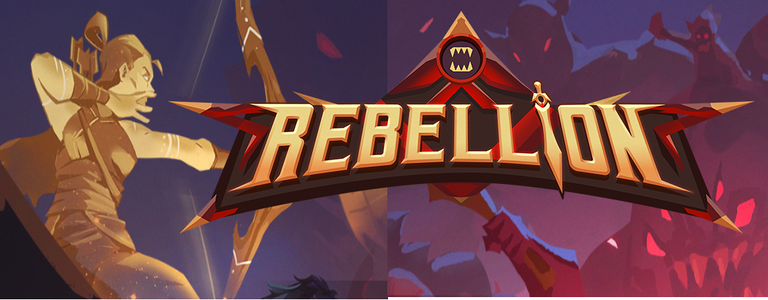
Since last week, cards from the Rebellion card set have been used in Splinterlands battles. The date of this critical transformation was previously announced. Still, it was a surprise to me because time passes so fast.
I've been playing the Modern version, which includes the Chaos Legion and Untamed card sets, for over a year. I have been finishing the season in the Champions League for the last six months. The change caused me concern. Would I be able to adapt to the change? The fact that I had yet to purchase a Rebellion card package also made my job difficult, as no Rebellion cards were available for rent, especially in the first few days. I was left without the comfort of summoners such as Kitty, Jodin Zaku, and Mylor Crowning in the Untamed card set. I had to develop many new strategies.
I rented a few key Rebellion cards and started playing. The consecutive defeats I suffered caused my anxiety level to increase. After 15-20 games, I noticed this: The opponents used almost no Rebellion cards. When I checked the battles of the Champion League, I encountered a similar sight. Although Rebellion card usage has increased slightly, Chaos Legion cards are still mainly used today.
My first impression of Rebellion was its small number of solid cards. After a week of using Rebellion cards, my opinion has not changed. A few powerful cards will be helpful in most situations, but each will be useful in certain games. On the other hand, learning the strategies that can be created using new cards will take time.
I'm glad to still be in the Champion League after a week. Over time, I started using some of the Rebellion cards. My attempts led to me losing many games, but no matter what, you can only make an omelet if you break the eggs.
There are 85 cards in the Rebellion card set. There are 14 cards in each element except Dragon and Neutral. Additionally, there are 5 Dragon and 10 Neutral cards. The best of the cards is, by far, Grimbardun Smith.

This card, like Baakjira, is almost unbeatable. Even when supported by a single healer, it survives until the end of the game because it contains Shield, Void, and Immunity features. The repair feature also increases the resistance of the card. Mainly, if Guardian supports Merdaali, it becomes impossible to destroy it. Grimbardun Smith's superior features are so evident that it is still the most expensive card in its maximum version. I intended to buy it, but I gave up when I saw the $400 price tag.
Rebellion came with new strategies as well as new cards. Ambush is the easiest to understand among the new features. I tried using cards with this feature several times, but my attempts were unsuccessful. Ambush cards should be used in fast teams. Thus, other cards can attack after overcoming the Ambush card and the opponent's defense. Summoners, which allow you to choose between two features, also interested me, but I still needed to be more motivated to use them. They can be helpful in some niche situations. Summoners that allow you to use two Splinters together look more attractive. The combination of Water and Life cards can produce striking results. Also, their Mana value of 3 is attractive.
Weapons training was a feature that came with soulbound reward cards. Those who regularly play the game have versions of the Soulbound reward cards suitable for their leagues because we have collected them for nearly a year. Two rebellion cards caught my attention in the context of weapons training. The first of these cards is Moxian Rebel. There are 11 weapons training cards. These cards generally have high mana value. Moxian Rebel requires four mana and is unique because it can be used even in games with small mana limits. The fact that this card is Neutral further expands its usage area.

The Camouflage feature ensures that the game remains intact until the end. It would be great if the firepower were three instead of 2, but it's still valid. They form a good duo with Grimbardun Smith, who will be used in the first row.
Another card in the Rebellion set that caught my attention is Runeseer Sevaya. A no-attack card, Runeseer Sevaya is worth four mana and has five extremely critical properties. The most important of these features is protection.

Another feature that makes this card attractive is that it is a Dragon. Since it can be used with other elements, its usage area is quite broad.
TL;DR
The Rebellion card set came into play, and the game's dynamics changed. I rented my Untamed cards; I continued with the Modern version. I'm renting the main Rebellion cards for now. Although the rents are high, I hope they will become more reasonable. I couldn't rent the Moxian Rebel card, so I had to buy it because it has a special place among Weapons Training cards.
Today, I had the chance to examine the new cards in detail. Apart from the ones I mentioned, 4-5 more cards caught my attention. I envisioned the rulesets that each could be used in, but I have yet to have the opportunity to try them.
Rebellion brought new excitement to the game while also supporting the SPS price. Due to this change, I had to devote more time to Splinterlands. By the way, I also really like the designs of the new cards.
The flying wheel concept, for which SPS and DEC supported each other's prices, started working with the support of the Land project. If the optimism in the market continues, the SPS price will continue to rise, and competition will become more challenging. I have never experienced the bull market in Splinterlands as a player. It will be interesting. I hope we see those days soon.
Thank you for reading.
